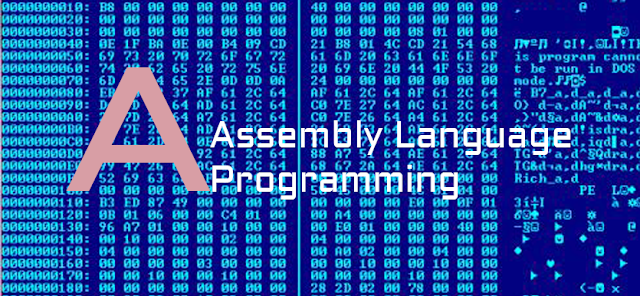Assembly Language programming : 8086 Assembler Tutorial (Part 7)
Program Flow Control
Controlling the program flow is a very important thing, this is where your program can make decisions according to certain conditions.
Another, yet rarely used method is providing an immediate value instead of a label. When immediate value starts with a '$' character relative jump is performed, otherwise compiler calculates instruction that jumps directly to given offset. For example:

Assembly Language : 8086 Assembler Tutorial Part 12
Assembly Language : 8086 Assembler Tutorial Part 11
Assembly Language : 8086 Assembler Tutorial Part 10
Assembly Language : 8086 Assembler Tutorial Part 9
Assembly Language : 8086 Assembler Tutorial Part 8
Assembly Language : 8086 Assembler Tutorial Part 7
Assembly Language : 8086 Assembler Tutorial Part 6
Assembly Language : 8086 Assembler Tutorial Part 5
Assembly Language : 8086 Assembler Tutorial Part 4
Assembly Language : 8086 Assembler Tutorial Part 3
Assembly Language : 8086 Assembler Tutorial Part 2
Assembly Language : 8086 Assembler Tutorial Part 1
Assembly Language Programming : Complete 8086 instruction sets
Assembly Language Programming : I/O ports - IN/OUT instructions
Assembly Language programming : Emu8086 Assembler Compiling and MASM / TASM compatibility
Assembly Language - string convert - Lowercase , Uppercase
for programming : the language of Number
Assembly Language - Complete Instruction Set and Instruction Timing of 8086 microprocessors
Assembly Language programming : A list of emulator supported interrupts
Assembly Language Programming : Emu8086 Overview, Using Emulator, Virtual Drives
Assembly Language Programming : All about Memory - Global Memory Table and Custom Memory Map
buy me a cup of coffee
buy me a cup of coffee
Need More Detail ? contact me !!
Send me any small amount of money is welcome.
___________________________________________
Don't know how to send money ? Click here for detail about Paypal account.
About PayPal Payment Methods
What type of PayPal accounts is better.
Don't have money? OK! Here is another way to get the program.
how to get my program - Free of charge

Program Flow Control
Controlling the program flow is a very important thing, this is where your program can make decisions according to certain conditions.
- Unconditional Jumps
The basic instruction that transfers control to another point in the program is JMP.
The basic syntax of JMP instruction:JMP label
To declare a label in your program, just type its name and add ":" to the end, label can be any character combination but it cannot start with a number, for example here are 3 legal label definitions:label1:
Label can be declared on a separate line or before any other instruction, for example:
label2:
a:x1:
Here is an example of JMP instruction:
MOV AX, 1
x2: MOV AX, 2
ORG 100h MOV AX, 5 ; set AX to 5. MOV BX, 2 ; set BX to 2. JMP calc ; go to 'calc'. back: JMP stop ; go to 'stop'. calc: ADD AX, BX ; add BX to AX. JMP back ; go 'back'. stop: RET ; return to operating system. END ; directive to stop the compiler.
Of course there is an easier way to calculate the some of two numbers, but it's still a good example of JMP instruction.
As you can see from this example JMP is able to transfer control both forward and backward. It can jump anywhere in current code segment (65,535 bytes).
- Short Conditional Jumps
Unlike JMP instruction that does an unconditional jump, there are instructions that do a conditional jumps (jump only when some conditions are in act). These instructions are divided in three groups, first group just test single flag, second compares numbers as signed, and third compares numbers as unsigned.
Jump instructions that test single flag
Instruction Description Condition Opposite Instruction JZ , JE Jump if Zero (Equal). ZF = 1 JNZ, JNE JC , JB, JNAE Jump if Carry (Below, Not Above Equal). CF = 1 JNC, JNB, JAE JS Jump if Sign. SF = 1 JNS JO Jump if Overflow. OF = 1 JNO JPE, JP Jump if Parity Even. PF = 1 JPO JNZ , JNE Jump if Not Zero (Not Equal). ZF = 0 JZ, JE JNC , JNB, JAE Jump if Not Carry (Not Below, Above Equal). CF = 0 JC, JB, JNAE JNS Jump if Not Sign. SF = 0 JS JNO Jump if Not Overflow. OF = 0 JO JPO, JNP Jump if Parity Odd (No Parity). PF = 0 JPE, JP
As you can see there are some instructions that do that same thing, that's correct, they even are assembled into the same machine code, so it's good to remember that when you compile JE instruction - you will get it disassembled as: JZ.
Different names are used to make programs easier to understand and code.
Jump instructions for signed numbers
Instruction Description Condition Opposite Instruction JE , JZ Jump if Equal (=).
Jump if Zero.ZF = 1 JNE, JNZ JNE , JNZ Jump if Not Equal (<>).
Jump if Not Zero.ZF = 0 JE, JZ JG , JNLE Jump if Greater (>).
Jump if Not Less or Equal(not <=). ZF = 0
and
SF = OFJNG, JLE JL , JNGE Jump if Less (<).
Jump if Not Greater or Equal(not >=). SF <> OF JNL, JGE JGE , JNL Jump if Greater or Equal (>=).
Jump if Not Less (not <).SF = OF JNGE, JL JLE , JNG Jump if Less or Equal (<=).
Jump if Not Greater(not >). ZF = 1
or
SF <> OFJNLE, JG
<> - sign means not equal.
Jump instructions for unsigned numbers
Instruction Description Condition Opposite Instruction JE , JZ Jump if Equal (=).
Jump if Zero.ZF = 1 JNE, JNZ JNE , JNZ Jump if Not Equal (<>).
Jump if Not Zero.ZF = 0 JE, JZ JA , JNBE Jump if Above (>).
Jump if Not Below or Equal(not <=). CF = 0
and
ZF = 0JNA, JBE JB , JNAE, JC Jump if Below (<).
Jump if Not Above or Equal(not >=).
Jump if Carry.CF = 1 JNB, JAE, JNC JAE , JNB, JNC Jump if Above or Equal (>=).
Jump if Not Below(not <).
Jump if Not Carry.CF = 0 JNAE, JB JBE , JNA Jump if Below or Equal (<=).
Jump if Not Above(not >). CF = 1
or
ZF = 1JNBE, JA
Generally, when it is required to compare numeric values CMP instruction is used (it does the same as SUB (subtract) instruction, but does not keep the result, just affects the flags).
The logic is very simple, for example:
it's required to compare 5 and 2,
5 - 2 = 3
the result is not zero (Zero Flag is set to 0).
Another example:
it's required to compare 7 and 7,
7 - 7 = 0
the result is zero! (Zero Flag is set to 1 and JZ or JE will do the jump).
Here is an example of CMP instruction and conditional jump:
include emu8086.inc ORG 100h MOV AL, 25 ; set AL to 25. MOV BL, 10 ; set BL to 10. CMP AL, BL ; compare AL - BL. JE equal ; jump if AL = BL (ZF = 1). PUTC 'N' ; if it gets here, then AL <> BL, JMP stop ; so print 'N', and jump to stop. equal: ; if gets here, PUTC 'Y' ; then AL = BL, so print 'Y'. stop: RET ; gets here no matter what. END
Try the above example with different numbers for AL and BL, open flags by clicking on [FLAGS] button, use [Single Step] and see what happens, don't forget to recompile and reload after every change (use F5 shortcut).
All conditional jumps have one big limitation, unlike JMP instruction they can only jump 127 bytes forward and 128 bytes backward (note that most instructions are assembled into 3 or more bytes).
We can easily avoid this limitation using a cute trick:
- Get a opposite conditional jump instruction from the table above, make it jump to label_x.
- Use JMP instruction to jump to desired location.
- Define label_x: just after the JMP instruction.
Here is an example:
include emu8086.inc ORG 100h MOV AL, 25 ; set AL to 25. MOV BL, 10 ; set BL to 10. CMP AL, BL ; compare AL - BL. JNE not_equal ; jump if AL <> BL (ZF = 0). JMP equal not_equal: ; let's assume that here we ; have a code that is assembled ; to more then 127 bytes... PUTC 'N' ; if it gets here, then AL <> BL, JMP stop ; so print 'N', and jump to stop. equal: ; if gets here, PUTC 'Y' ; then AL = BL, so print 'Y'. stop: RET ; gets here no matter what. END
Another, yet rarely used method is providing an immediate value instead of a label. When immediate value starts with a '$' character relative jump is performed, otherwise compiler calculates instruction that jumps directly to given offset. For example:
ORG 100h
; unconditional jump forward:
; skip over next 2 bytes,
JMP $2
a DB 3 ; 1 byte.
b DB 4 ; 1 byte.
; JCC jump back 7 bytes:
; (JMP takes 2 bytes itself)
MOV BL,9
DEC BL ; 2 bytes.
CMP BL, 0 ; 3 bytes.
JNE $-7
RET
END
|

emu8086 is better than NASM, MASM or TASM
Tag: assembly language, assembly instruction, assembly programming, assembly code, assembly guide, emu8086, 8086 microprocessors instruction, instruction sets, instruction sets for 8086, instruction complete set, instruction set complete for 8086, assembly language instruction set, complete 8086 instruction sets microprocessors, complete instruction timing and instruction sets for 8086 microprocessors, 8086 Assembler, TutorialAssembly Language : 8086 Assembler Tutorial Part 12
Assembly Language : 8086 Assembler Tutorial Part 11
Assembly Language : 8086 Assembler Tutorial Part 10
Assembly Language : 8086 Assembler Tutorial Part 9
Assembly Language : 8086 Assembler Tutorial Part 8
Assembly Language : 8086 Assembler Tutorial Part 7
Assembly Language : 8086 Assembler Tutorial Part 6
Assembly Language : 8086 Assembler Tutorial Part 5
Assembly Language : 8086 Assembler Tutorial Part 4
Assembly Language : 8086 Assembler Tutorial Part 3
Assembly Language : 8086 Assembler Tutorial Part 2
Assembly Language : 8086 Assembler Tutorial Part 1
Assembly Language Programming : Complete 8086 instruction sets
Assembly Language Programming : I/O ports - IN/OUT instructions
Assembly Language programming : Emu8086 Assembler Compiling and MASM / TASM compatibility
Assembly Language - string convert - Lowercase , Uppercase
for programming : the language of Number
Assembly Language - Complete Instruction Set and Instruction Timing of 8086 microprocessors
Assembly Language programming : A list of emulator supported interrupts
Assembly Language Programming : Emu8086 Overview, Using Emulator, Virtual Drives
Assembly Language Programming : All about Memory - Global Memory Table and Custom Memory Map
buy me a cup of coffee
My Paypal Account is : ksw.industries@gmail.com
Send me any small amount of money is welcome.buy me a cup of coffee
___________________________________________
Need More Detail ? contact me !!
My Paypal Account is : ksw.industries@gmail.com
buy me a cup of coffeeSend me any small amount of money is welcome.
___________________________________________
Don't know how to send money ? Click here for detail about Paypal account.
About PayPal Payment Methods
What type of PayPal accounts is better.
Don't have money? OK! Here is another way to get the program.
how to get my program - Free of charge

No comments:
Post a Comment